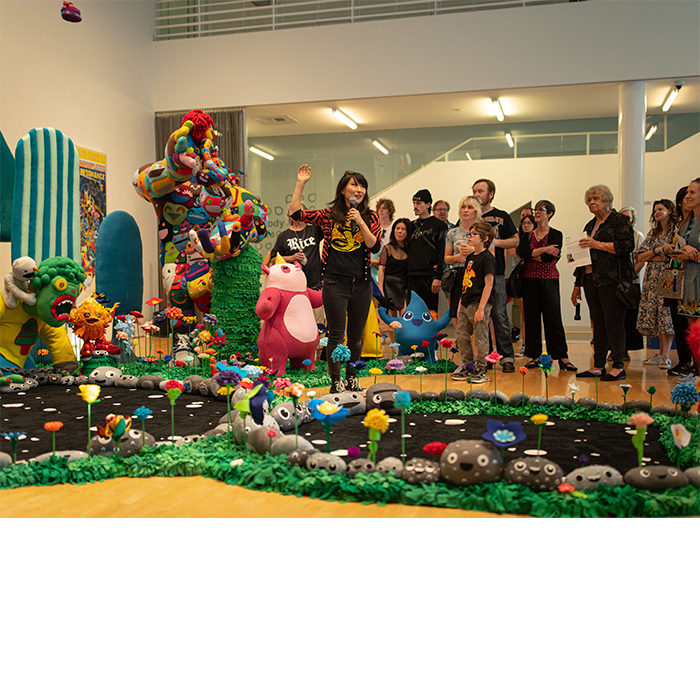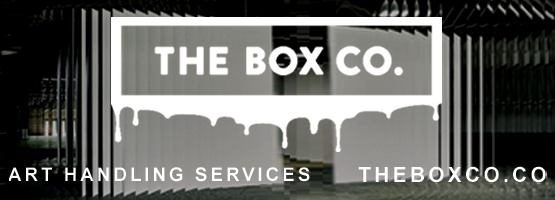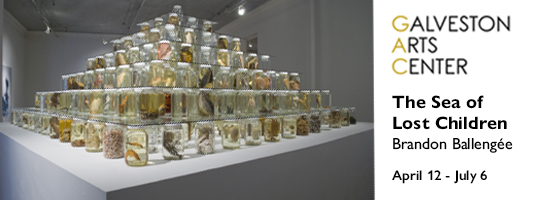Forget the latest superhero blockbuster, this summer we’re nabbing our (free) ticket to experience the ongoing adventures of Pound Cake Man, Sweet Slice, Prime Weaver, Pom Pom Thunder, Vorax and the newest powerful force for radical change in perception, Wondervision. They’ll travel via inter-dimensional space portal to save the cosmos, reunite the lost and occasionally deliver life-affirming (and delicious) kindness pies.
In the last decade, major Texas museums and galleries have presented Choi’s work, but this summer brings the perfect chance to teleport directly into Choi’s artistic universe with two overlapping shows, Love and Wondervision at Rice University’s Moody Center for the Arts (May 25-Aug. 26) and Discovering Truth Will Make Me Free at Inman Gallery (July 15-Sept.1 ).
Born in South Korea, adopted at a young age and raised in New Hampshire, Choi uses her real experiences and her vast imagination to create visual art that depicts complex, joyful narratives. Critics tend to use terms like paracosm to describe her inner world she manifests on canvas and as soft sculptures of wise bed-beings or orange, benevolent-cybernetic rabbits.
Yet, after listening to Choi discuss her painted and sculpted narrative landscapes, which she calls the Cosmic Womb, I’d use a more prevalent pop culture term, world-builder. Since childhood, Choi has built universes in her mind and populated them with colorful, fuzzy and furry, characters. Now as an adult instead of pouring those characters and their adventures into sprawling novel series, she makes visual art across mediums to present them to our world.
“There was a lot of power playing with the idea of the imaginary and the real,” she explains. “Even at a young age, I started to realize you can either feel like you’re out of control and everyone else is in control of what’s real or what’s not, or you can learn to play with it so it doesn’t hurt, scare or intimidate you. You can find humor and joy and confront it in a new way.”
For Love and Wondervision, Choi deconstructs the boundaries between real and imaginary to such an extent that the show becomes a kind of meta-commentary on the act of an art space presenting an exhibition.
The centerpiece of the show will be Like a Bolt Out of the Blue, Faith Steps In and Sees You Through—Infinite Feels Arrangement, an immense, narrative installation that brings together several of her painted and sculpted characters on a mission to reunite children with their loved ones after an intergalactic conflict. Choi puts Pom Pom Thunder, the sentient bed, as the central figure of the installation.
“What if there was a super highway of dreams and this magical bed with these magical shoes could fly on the superhighway and find people and reconnect them,” she explains of the initial concept. “That’s when I came up with Pom Pom Thunder.”
Along with Pom Pom, Like a Bolt depicts a giant, galactic travel portal and a sculpted cast of characters who aid in the magic of the reunions and welcome travelers.

1 ⁄8
JooYoung Choi, Like a Bolt Out of the Blue, Faith Steps In and Sees You Through—Infinite Feels Arrangement, installation view, JooYoung Choi: Love and Wondervision, May 25 – August 26, 2023, Moody Center for the Arts at Rice University. Photo by Gustavo Raskosky.

2 ⁄8
JooYoung Choi, Spectra Force Vive: Infinite Pie Delivery Service, installation view, JooYoung Choi: Love and Wondervision, Moody Center for the Arts at Rice University. Photo by Allyson Huntsman.

3 ⁄8
JooYoung Choi addresses attendees at the opening reception for Love and Wondervision, May 25, 2023 at the Moody Center for the Arts at Rice University. Photo by Allyson Huntsman.

4 ⁄8
JooYoung Choi, Always Love You, 2022
Acrylic, gouache, vinyl paint, carbon transfer, and cut paper on canvas
60 x 48 in (152.4 x 121.9 cm)
Courtesy the artist and Inman Gallery, Houston. Photo by Thomas R DuBrock.

5 ⁄8
JooYoung Choi, Venatorious Stomp and the Courage Vampires, 2022
acrylic and cut paper on canvas. 40 x 30 x 1 3/4 in (101.6 x 76.2 x 4.4 cm). Courtesy the artist and Inman Gallery, Houston. Photo by Thomas R DuBrock.

6 ⁄8
JooYoung Choi, installation view of Roro Puppet; Volcana Puppet; Paracosmic Viewing Station & Pleasure Vision Transmission Receiver [Gen. 1] Red; Rem and Vorax; Bunnie and Sweet Slice; and Mondo and Dee, at the Moody Center for the Arts at Rice University. Photo by Allyson Huntsman.

7 ⁄8
JooYoung Choi, Songs of Resilience for the Tapestry of Faith. Photo by Thomas DuBrock, courtesy of Inman Gallery.

8 ⁄8
JooYoung Choi, Table of Love. Photo by Thomas DuBrock, courtesy of Inman Gallery.
“These are aliens from outer space,” acknowledges Choi, but she also believes viewers might think about the term “alien” when it comes to issues of immigration, border crossings and safe spaces.
“Creating these pieces that kind of touch on things that are happening in the real world, but being able to put them in a narrative context, makes them accessible to a larger audience. A child can come in and enjoy them for the color, for the characters, but I feel like for adults it can also be a way for them to talk through their feelings about very complicated issues.”
“I just wanted to create something that encouraged the importance of empathy for those who are dealing with conflict and aren’t able to unite with the people they love,” she adds.
But Choi has also drawn a narrative frame around the installation with the backstory that Cosmic Womb royalty, Queen Kiok, asked Choi, the artist, to act as an ambassador between Earth and the cosmos to find safe reunion spaces. With help from museum and gallery curators, an art space becomes a reunion center in the story. And so the Moody Center itself gets drawn into the narrative and becomes a metaphor for art as a force and place for love and connection.
As we talked about Table, I asked Choi how the story feeds the conception of each work and wondered if it drives the composition.
“As much as I love narrative, the color, the texture, everything, has to have a certain level of harmony, of dynamic composition,” she describes, but sometimes that can lead to the discovery of a whole new character.
Hugs, the delightful, running cactus sculpture is such an example of a character’s creation originating from aesthetic need. Working on a project for the Houston Endowment, Choi realized a space in the artwork needed a dynamic green image, like an arrow.
“So I created this running cactus character, and then I missed him so much,” she describes with an emphasis on “so.”
I ended up wondering what he would look like if he was 3-D,” After giving him a body, his presence sent her on an imaginative quest for a name, backstory and personality. The cactus became Hugs, which sent him off on an adventure to learn how to hug people without pricking them.
The exhibition will also showcase many of the sculpted puppets from the film in all their sci fi-costumed glory.
Though deep in the work for Love and Wonder when we talked, Choi said that the Inman Gallery show, Discovering Truth Will Make Me Free, would focus primarily on her paintings made between 2015 and 2022.
“That one is so much fun. There’ve been so many paintings that I created for different institutions, but they’ve never been shown all together here in Houston,” she said, adding “That one deals more with time and the relationship of the characters over time.”
Viewed together, the paintings in the Inman show will allow viewers to see some of those truth-discoveries of the title as well as how the characters have changed over the course of her work and the passage of time within the Cosmic Womb.
“It’s like a 360 [change] when you realize: where I thought there was nothing, there’s actually a great opportunity. You put on your Wondervision glasses,” she explains.
The concept is, of course, universal, to see in a new light, but it also applies in specific ways to Choi’s personal experiences.
“I used to think being adopted and not knowing so much about my life made me feel empty, but actually it created a space for so much creativity and so many new experiences.”
—TARRA GAINES







